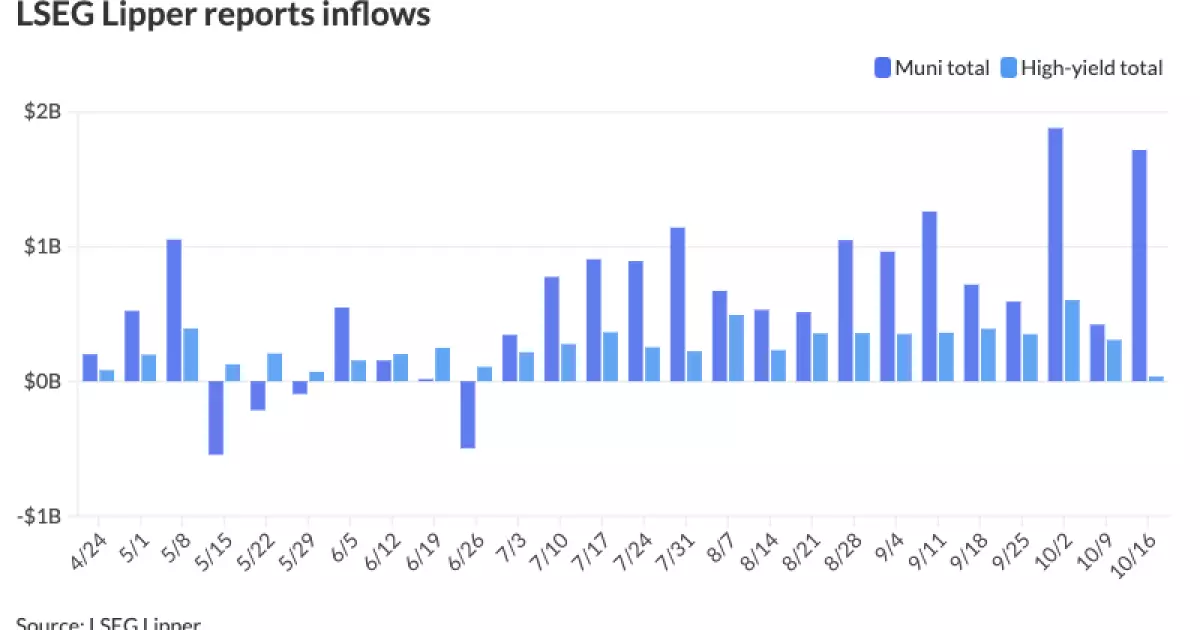The Current State of the Municipal Bond Market: An Analysis of Recent Trends and Developments

As the municipal bond market evolves, recent trading dynamics reveal a relatively stable environment for municipal securities, despite ongoing fluctuations in broader financial markets. The municipal bond mutual fund segment has demonstrated remarkable resilience, largely fueled by consistent inflows. For instance, during the week ending Wednesday, investors contributed a notable $1.718 billion to municipal bond mutual funds, significantly higher compared to the $420.7 million from the prior week. This marks an impressive streak of 16 consecutive weeks of inflows, showcasing robust investor interest amidst changing economic landscapes.
The primary market has also seen a flurry of activity, highlighted by major issuances underpinned by substantial demand. A significant driver of this activity came from the New Jersey Transportation Trust Fund Authority, which successfully upsized its offering to $3.2 billion in transportation bonds. Such offerings underscore the importance of infrastructure financing, particularly as municipalities work to bridge funding gaps exacerbated by the COVID-19 pandemic and subsequent fiscal challenges.
Parallel to municipal bond movements, U.S. Treasuries have recently experienced a downturn, particularly in longer maturities. Meanwhile, the relationship between municipal yields and Treasury rates—often gauged by the muni-to-Treasury ratio—has provided valuable insights into market sentiment and investor behavior. On Thursday, the two-year muni-to-Treasury ratio was reported at 62%, with corresponding ratios for three-year and five-year maturities also standing at 62% and 63%, respectively. Notably, the 30-year ratio climbed to 83%, indicating a favorable valuation for long-dated municipal securities as investors appear to chase yields.
Such ratio trends are often reflective of investor sentiment towards credit quality and interest rate movements. Analysts from J.P. Morgan have observed that positive fund flows in the municipal market are closely associated with the Federal Reserve’s easing cycles since the early 1990s. As fixed-income managers highlight, when the rates are declining, municipal returns tend to improve, prompting investors to consider this asset class more favorably.
The uptick in municipal bond issuance can be traced to a backlog of projects and funding requirements that have built up over the years, compounded by market disruptions such as the COVID-19 pandemic. Many issuers appear to be mobilizing to address these deferred projects, seeking to tap into favorable market conditions characterized by high demand and investor appetite. This elevated supply scenario emphasizes the importance of strategic planning in public finance, as municipalities strive to align their needs with available capital.
Kim Olsan, a senior fixed income portfolio manager, noted that forward supply is projected to hover around $20 billion, while offsetting calls and maturities may rest at approximately $18 billion. This net supply condition is crucial, potentially allowing skilled issuers to attract substantial investor interest, particularly for high-yield or lower-rated credits.
Conversely, while lesser-rated bonds have attracted good oversubscription, higher-rated offerings (AA-rated and above) have needed to entice investors with slightly higher yields to ensure successful placements, altering the historical pricing dynamics that previously characterized this sector.
A quick snapshot of recent transactions provides insight into the health of the market and the types of issuances dominating current discussions. Notable offerings include Pennsylvania’s sale of $1.6 billion of general obligation (GO) bonds across three series, while Chicago O’Hare International Airport issued $1.6 billion in senior lien revenue bonds. The strong order books associated with these major deals point to investor confidence and a deepening engagement with municipal debt.
Looking ahead, market experts predict that the continuation of positive fund flows, coupled with a vigorous slate of upcoming issuances, will play a fundamental role in shaping the trajectory of the municipal bond market. The interplay between demand for yields and prevailing interest rate environments will ultimately guide investor behavior. As capital flows in this sector persist, it stands to highlight the growing recognition of municipal securities as a viable option for portfolio diversification and yield enhancement in the current economic climate.
The municipal bond market is presently enjoying a period of activity catalyzed by strong inflows and substantial issuance. Investors remain drawn to this asset class, motivated by favorable yield dynamics and a resurgence of supply responding to infrastructure needs. As financial markets continue to fluctuate, municipalities will likely play a pivotal role in shaping the landscape of public finance through innovative financing strategies and careful management of their debt portfolios. The outlook remains optimistic, as fundamentals support the continued growth and interest in municipal bonds. With thoughtful engagement and strategic decisions, the future of this market segment appears promising.





